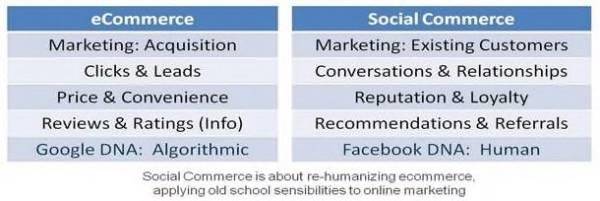Everyone, especially Wall Street, is standing up to salute social commerce. Look at the IPO pipeline – LinkedIn, Groupon, Zynga, Living Social. But despite all this attention, the definition of social commerce is fuzzy at best. How do we know if these companies will win, if we can’t even agree on what it is?

When defining something social, it’s helpful to characterize it by the conversations that make up the experience. I’ve observed three elemental commerce-related conversations currently taking place: shopping, marketing and trading.
Craig Donato is the Founder and CEO of Oodle, a social marketplace that also powers Facebook Marketplace. Prior to Oodle, Donato was CEO of Grand Central Communications and a senior vice president at Excite@Home.
Social Shopping
When I’m thinking about buying something – especially something expensive or something that I simply care about a lot – I talk to people I trust. Social media makes this much easier to do. It lowers the barriers of effort and social appropriateness around having this conversation. Six months ago, I was looking for a camcorder (the video function on my phone just wasn’t cutting it for filming the school plays). While I would never have taken the time to email all my friends to ask which camcorders they liked (that would just be weird), I felt totally comfortable soliciting their thoughts on Facebook. This open conversation introduced two new elements into the commerce equation: impulse and serendipity. As people chimed in and the conversation took shape, a few friends who hadn’t really been looking for camcorders became interested in and purchased the same model I bought.
Social shopping is rooted in the overall shift we’re seeing – consumers engaging in the social discovery of everything. Rather than just searching for information, consumers are increasingly turning to Facebook and Twitter to get trusted recommendations. We already see this significantly affecting the way they’re discovering and consuming news. Moving forward, sharing trusted recommendations will only continue to grow as a huge factor in how people discover what to buy. Last year, Facebook commissioned a study by Nielsen which confirmed the obvious: trusted recommendations have a huge impact on the decision-making process. People were four times more likely to buy something when it was recommended by a friend.
It definitely worked in my case.
Social Marketing
Businesses need to talk with their customers. For millennia, this conversation occurred face-to-face in markets or in storefronts. Unfortunately, this dialogue has devolved into what is now primarily a one-way conversation: “marketing.”
Businesses need to talk with their customers. For millennia, this conversation occurred face-to-face in markets or in storefronts. Unfortunately, this dialogue has devolved into what is now primarily a one-way conversation: “marketing.”
Social media introduces a less-intrusive, more organic way to converse with customers rather than blasting them with emails or direct mail pieces. When done well, it reintroduces a two-way conversation between the business and its customers. These conversations, because they occur openly, have the opportunity to fuel word-of-mouth awareness. They also have a
. If a business fails to engage me by sending me too much stuff or stuff I ignore, messages from that business start disappearing from my Facebook newsfeed. Similarly on Twitter, great content is retweeted; noisy accounts are easily unfollowed.
This style of two-way, conversational marketing through social media (beyond just customer support) will likely take off first with small businesses. They’ve always valued the business-growing power of marketing through their existing customers for building loyalty and fueling word-of-mouth referrals. It’s why they prioritize customer service and cultivate their reputation in the local community. It’s why they join the Rotary and sponsor Little League teams.
Social media just removes a ton of friction from this process.

Social Trading
In real life, we often engage in trading within our hyper-local communities and social circles – lending stuff to neighbors, giving away the stuff our kids have outgrown, and so forth. This kind of trading is motivated as much by the desire to do social good as it is by the prospect of monetary reward. For example, if I have extra tickets to a concert, I could take the time to sell them to the highest bidder on StubHub. But I’d rather give them to a friend or sell them at face value to someone in the office. Unfortunately, this is harder than it should be. Garage sales are total a pain in the ass to pull off, not even taking into account all the random people that you have to deal with, and there’s typically no easy way to communicate with my important local communities: friends, co-workers, classmates, neighbors.
In real life, we often engage in trading within our hyper-local communities and social circles – lending stuff to neighbors, giving away the stuff our kids have outgrown, and so forth. This kind of trading is motivated as much by the desire to do social good as it is by the prospect of monetary reward.
Of the three, this conversation is the most nascent in social media. Many trading conversations work best when they take place
more broadly than just among “friends.”
As real-world local communities begin to emerge in the social graph (co-workers, classmates, neighbors), social trading will really take off.
What’s makes me confident that social commerce (as defined by shopping, marketing and trading) is the real deal is that it’s based on conversations that frequent our daily lives – conversations that simply work better in social media. The inherently-human nature of these conversations was perhaps best described by Rick Levine, et al in the Cluetrain Manifesto:
“For thousands of years, we knew exactly what markets were: conversations between people who sought out others who shared the same interests. Buyers had as much to say as sellers. They spoke directly to each other without the filter of media, the artifice of positioning statements, the arrogance of advertising, or the shading of public relations.
“These were the kinds of conversations people have been having since they started to talk. Social. Based on intersecting interests. Open to many resolutions. Essentially unpredictable. Spoken from the center of the self.”
Portobello Road photo from geograph










